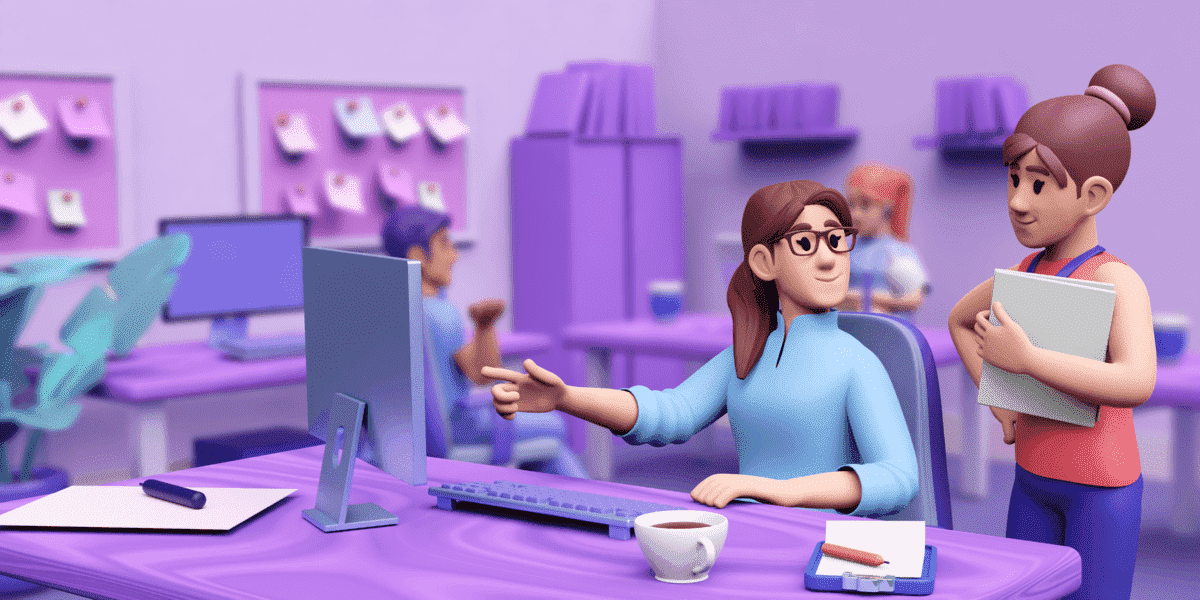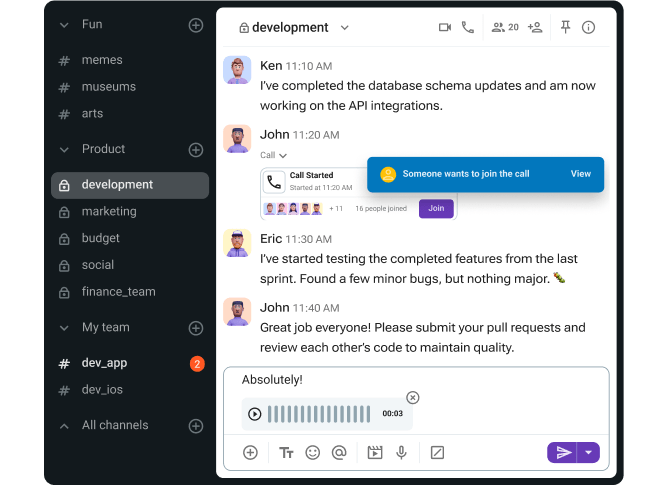O poder do trabalho em equipe e da colaboração no local de trabalho está no potencial de aproveitar a inteligência coletiva, a criatividade e as habilidades de um grupo. A colaboração aumenta a produtividade e a resolução de problemas e promove um ambiente de trabalho saudável.
Nas palavras de Helen Keller: "Sozinhos podemos fazer tão pouco; juntos podemos fazer tanto."
Neste guia, exploraremos estratégias, benefícios e dicas práticas sobre como você pode promover o trabalho em equipe e a colaboração no local de trabalho.
Responderemos às seguintes perguntas:
- Como você pode promover o trabalho em equipe e a colaboração
- Quais são as habilidades mais importantes para o trabalho em equipe e a colaboração
- Quais são os benefícios do trabalho em equipe e da colaboração
Vamos começar.

Como promover o trabalho em equipe e a colaboração?
Criar um ambiente de trabalho colaborativo é um processo deliberado e imersivo. Mas não precisa ser difícil. Vamos mergulhar e descobrir como alcançar melhor o trabalho em equipe e colaboração no seu local de trabalho.
Dica #1: Comunique objetivos comuns
Os membros da equipe não podem colaborar se não souberem quais são seus objetivos comuns.
Certifique-se de delinear claramente os objetivos que são comuns para todos os membros da equipe e faça isso com frequência.
Você pode organizar reuniões mensais, semanais ou até mesmo diárias com sua equipe para comunicar os objetivos para esse período. Você deve definir objetivos concretos para projetos em andamento, como uma data de vencimento ou um padrão de qualidade que precisa ser atingido.
Objetivos comuns também devem ser definidos em um nível organizacional. Isso também deve ser discutido com frequência com todas as equipes para unificar toda a organização sob os mesmos objetivos abrangentes.
Definir objetivos ajuda os funcionários a entenderem em que estão trabalhando — qual é o objetivo final. Isso aumenta a motivação e cria um senso de união entre os membros da equipe.
Comunique metas e defina expectativas sobre o Pumble
Dica #2: Defina expectativas para colaboração
Se você quer promover colaboração e trabalho em equipe, os membros da sua equipe precisam estar cientes de que colaboração é o que é esperado Em outras palavras, definir expectativas claras de colaboração é necessário para encorajar o trabalho em equipe.
Quando você estabelece expectativas, os membros da equipe têm um entendimento de que precisam:
- Trabalhar juntos
- Compartilhar responsabilidades
- Contribuir para o sucesso da equipe
Além disso, cada membro da equipe deve saber exatamente como e o que se espera que contribua para a equipe. Delegue tarefas e responsabilidades de acordo com os pontos fortes e habilidades individuais.
Ao definir expectativas e metas claras, você:
- Esclarece funções e responsabilidades
- Evita mal-entendidos e ambiguidades
- Garante fluxo de trabalho rápido
Dica #3: Aprecie os pontos fortes individuais
O melhor trabalho em equipe acontece quando cada membro da equipe tem a oportunidade de brilhar.
Para que isso aconteça, certifique-se de apreciar os pontos fortes individuais de cada membro da equipe. Como cada pessoa traz um conjunto único de experiências, habilidades e perspectivas para a mesa, atribua tarefas com base nessas características individuais e observe a equipe prosperar.
Quando os membros da equipe se sentem valorizados e apreciados, eles se sentirão mais motivados a se destacar.
Sempre elogie as contribuições individuais, e os membros da equipe serão encorajados a continuar colaborando.
Dica #4: Promova a comunicação aberta
A colaboração não pode acontecer sem comunicação. O foco deve estar sempre na comunicação aberta e transparente entre os membros da equipe.
Nossa colaboradora, Iva Marinkovic, especialista sênior em employer branding na Smallpdf e especialista em comunicação, acredita que a transparência é crucial:

“Lembre-se de que a transparência é a chave para uma colaboração saudável, então garanta que ninguém se sinta excluído ou no escuro.”
A comunicação aberta criará um ambiente onde todos se sintam confortáveis para compartilhar ideias, preocupações e feedback. Portanto, as pessoas estarão mais propensas a compartilhar informações, trocar opiniões e apresentar novas ideias, que é o objetivo final da colaboração.
Além disso, a comunicação aberta deve ser nutrida no nível organizacional e incluída nos valores essenciais da organização. Dessa forma, os funcionários estarão cientes de que a comunicação aberta e honesta é esperada o tempo todo.
Além disso, esforce-se para ter uma comunicação direta, pois ela simplifica as conversas e não deixa espaço para erros na comunicação.
Sempre incentive o diálogo aberto na equipe para promover uma troca saudável de ideias e opiniões e impulsionar a colaboração.
Compartilhe informações, arquivos e documentos pelo Pumble
Dica #5: Comemore o trabalho em equipe bem-sucedido
Se você quiser promover a colaboração, certifique-se de comemorar e recompensar bons exemplos de trabalho em equipe. Destacar o trabalho em equipe bem-sucedido aumentará a moral dos funcionários e reforçará o valor do trabalho em equipe.
Isso também aproximará a equipe, pois eles compartilharão um senso de realização e orgulho quando forem elogiados por seu bom trabalho em equipe. Isso os motivará a continuar colaborando.
No entanto, não se esqueça de comemorar as conquistas individuais dos membros da equipe, como já mencionamos.
Nossa colaboradora, Iva Marinkovic, concorda que o reconhecimento é um motivador poderoso:

"Uma das melhores opções para incentivar o trabalho em equipe é reconhecer os esforços colaborativos individuais. Reconhecer esses membros da equipe e dar a eles espaço para defender essa cultura é uma ótima maneira de motivar a equipe para uma colaboração maior."
Comemorar o trabalho em equipe bem-sucedido incentivará os funcionários a continuarem trabalhando juntos, pois suas conquistas estão sendo reconhecidas.
Dica #6: Utilize ferramentas de colaboração
O uso de ferramentas de colaboração, como aplicativos de comunicação, é outra excelente maneira de promover o trabalho em equipe. Essas ferramentas fornecem uma plataforma digital para comunicação e colaboração, independentemente da localização geográfica ou fuso horário. Isso torna as ferramentas de comunicação especialmente importantes para equipes híbridas ou remotas.
Usar um aplicativo de comunicação permite que as equipes se conectem, compartilhem informações e colaborem em tempo real, mesmo que não estejam fisicamente juntas.
Os aplicativos de comunicação também servem como um espaço para armazenar e acessar documentos, arquivos e outras informações importantes. Isso garante que as equipes estejam sempre na mesma página.
Outro tipo de ferramenta de colaboração que promove o trabalho em equipe são os aplicativos de gerenciamento de tarefas.
Os aplicativos de gerenciamento de tarefas oferecem recursos como:
- Acompanhamento de projetos
- Gerenciamento de tarefas
- Compartilhamento de arquivos
Usar ferramentas de colaboração ajudará as equipes a superar barreiras de comunicação e a acompanhar o progresso umas das outras. Isso acabará levando a uma melhor colaboração e trabalho em equipe.
Dica #7: Crie relacionamentos
O trabalho em equipe ocorrerá naturalmente em equipes que estão conectadas em mais do que um nível profissional.
De acordo com dados coletados pela Gallup, os funcionários que têm um "melhor amigo" no trabalho têm mais probabilidade de se envolver em seu trabalho e ter um desempenho melhor do que aqueles que não têm.
Construir relacionamentos pessoais entre os membros da equipe certamente trará mais colaboração e trabalho em equipe para o local de trabalho. Fortes conexões pessoais criam confiança e respeito mútuo, ambos necessários para o trabalho em equipe.
Além disso, os indivíduos que se conhecem em um nível pessoal têm mais probabilidade de:
- Comunicar-se abertamente
- Ajudar uns aos outros
- Respeitar as perspectivas uns dos outros
Quando as pessoas estão conectadas pessoalmente, elas são mais inclinadas a ter empatia umas com as outras. Isso promove um ambiente positivo, onde as pessoas se sentem mais confortáveis expressando suas opiniões e compartilhando ideias.
Iva destaca a importância de integrar novos funcionários e apoiá-los enquanto eles conhecem a equipe:

“Para novos contratados, é importante ter uma sessão de integração dedicada, apresentando-os à cultura e aos valores da empresa, fluxos de trabalho e rituais de toda a organização. Depois disso, seu líder pode assumir e apoiá-los para conhecer a equipe. O ‘sistema de amigos’ também é uma ótima maneira de apresentar novos membros à equipe e fornecer a eles um sistema de suporte.”
Em um nível organizacional, funcionários que estão pessoalmente investidos em suas equipes ficarão mais satisfeitos e engajados no trabalho. O mesmo relatório da Gallup indica que pessoas que desenvolvem relacionamentos pessoais com membros da equipe ficam mais satisfeitas com seu trabalho e são mais propensas a recomendar sua empresa como um bom lugar para trabalhar.
No geral, construir relacionamentos pessoais entre membros da equipe estabelece uma base para um trabalho em equipe forte e bem-sucedido.
Dica #8: Promova a cultura e os valores da empresa
A cultura e os valores da sua empresa podem ajudar muito a incentivar o trabalho em equipe entre os funcionários.
Uma cultura empresarial forte e positiva fornece um conjunto de crenças, valores e objetivos compartilhados que conectam todos os funcionários. Quando a cultura da sua empresa incentiva o trabalho em equipe e a colaboração, ela se torna uma parte inerente do local de trabalho.
Além disso, quando os funcionários sentem um senso de pertencimento e se identificam com os mesmos valores que os membros da equipe, eles ficam mais abertos à comunicação e ao vínculo entre si. Isso, por sua vez, promove o trabalho em equipe e a colaboração.
Além disso, um ambiente de trabalho positivo que valoriza ideias individuais pode atrair e reter membros talentosos da equipe.
Você incentivará a colaboração no local de trabalho se valorizar:
- Comunicação aberta
- Respeito por ideias diferentes
- Suporte mútuo
A cultura da empresa e os valores que ela mantém devem ser claramente comunicados ao contratar novas pessoas para garantir que elas estejam alinhadas.
Iva Marinkovic concorda que é importante contratar pessoas com os mesmos valores:

“Um ambiente de trabalho colaborativo, no melhor dos casos, deve vir organicamente da cultura geral que você construiu. Isso significa que você pensará fortemente sobre cada contratação e avaliará se ela é uma boa opção cultural para sua equipe. Se um dos valores da sua empresa for colaboração, você procurará por isso em cada candidato que entrevistar e contratará aquele que funcionar melhor para a equipe.”
Ao criar e manter uma cultura empresarial positiva e colaborativa, o trabalho em equipe será visto como uma parte esperada do ambiente de trabalho.
Promova a cultura da empresa de forma transparente no Pumble
Dica #9: Encoraje a criatividade
Encorajar a criatividade é essencial quando você quer promover o trabalho em equipe.
Em um ambiente de trabalho diverso, compartilhar ideias diferentes e respeitar as diferenças deve ser encorajado. Para ter ideias novas e criativas, precisamos abraçar nossas diferenças.
Ao criar um ambiente que incentiva a criatividade, os membros da equipe podem se expressar livremente, explorar novas ideias e correr riscos. A criatividade promove a colaboração, pois os membros da equipe podem compartilhar e desenvolver as ideias uns dos outros.
Além disso, quando os líderes criam um ambiente que incentiva a criatividade, mesmo aqueles que são menos criativos naturalmente têm mais probabilidade de se tornarem criativos, de acordo com pesquisas. A liderança deve ser organizada de uma forma que alimente a criatividade dos funcionários.
A criatividade alimenta:
- Inovação
- Resolução de problemas
- Pensamento inovador
Ao abraçar a criatividade, você explora todo o potencial das equipes e impulsiona a colaboração entre os membros.
Dica #10: Seja um líder colaborativo
Um líder que é bom em colaboração inspirará os outros a fazerem o mesmo.
Seja um líder que respeita as diferenças de opinião e incentiva ativamente o compartilhamento de ideias. Certifique-se de não se transformar em um líder que apenas comanda e controla — em vez disso, colabore.
Iva concorda que a colaboração começa com o líder:

“Você precisa criar um ambiente seguro e de apoio onde as pessoas confiem umas nas outras e possam contar umas com as outras. Aqui, seu ativo mais vital será o líder da equipe, que deve liderar pelo exemplo e não microgerenciar, mas colaborar com a equipe.”
Em muitos casos, os líderes são vistos como figuras que induzem medo. Faça o seu melhor para criar uma atmosfera positiva sendo parte da equipe, e não apenas um superintendente.
Aqui está um exemplo de como um líder de equipe demonstra liderança colaborativa pedindo a opinião dos membros da equipe sobre a frequência com que eles devem realizar reuniões de check-in:

Peça e dê feedback pelo Pumble
Ao ser um líder colaborativo para sua equipe você os inspirará a trabalhar melhor juntos.
Dica #11: Invista em atividades de formação de equipe
Atividades de formação de equipe são uma ótima maneira de promover indiretamente o trabalho em equipe e a colaboração no local de trabalho.
Mais especificamente, atividades de formação de equipe criam uma oportunidade para as equipes se conectarem, construírem confiança e desenvolverem habilidades eficazes de comunicação e colaboração. Ao se envolver em atividades de formação de equipe, os membros da equipe têm a chance de:
- Quebrar barreiras
- Melhorar a comunicação
- prender mais sobre cada
- Apreciar as habilidades e pontos fortes de cada um
Se você organizar atividades divertidas, e perspicazes de formação de equipes, você incentivará:
- Participação ativa
- Resolução de problemas e tomada de decisões em equipe
- Espírito de equipe e senso de comunidade
No nível organizacional, as atividades de formação de equipes aumentarão o moral dos funcionários, a satisfação no trabalho e a motivação. Isso levará ao aumento da produtividade, bem como à retenção de funcionários.
Em última análise, as atividades de formação de equipes são uma ótima maneira de criar uma equipe coesa e colaborativa que pode superar desafios juntos e alcançar maior sucesso.
🎓 Dica profissional do Pumble
Se você está sem ideias para atividades virtuais de formação de equipes, dê uma olhada em nossa compilação de atividades:
Dica #12: Monitore metas e progresso
Monitorar o progresso é uma parte necessária do trabalho em equipe e da colaboração.
Acompanhar o progresso regularmente garantirá que todos estejam no caminho certo para atingir suas metas. Também lhe dá a oportunidade de identificar quaisquer obstáculos logo no início e resolvê-los.
Controles regulares também promoverão responsabilização e responsabilidade compartilhada. Os membros da equipe podem permanecer focados em seu trabalho sabendo que todos estão no caminho certo.
Além disso, acompanhar o progresso ajudará você a entender se algum recurso ou orientação adicional pode ser necessário.
Iva nos dá alguns exemplos de como você pode fazer o controle com sua equipe:

“Para monitorar o sucesso da sua equipe, você pode ter reuniões semanais de equipe, check-ins de projetos e reuniões individuais, onde você falará sobre o progresso, oferecerá ajuda e removerá quaisquer obstáculos que as pessoas possam ter.”
Como líder colaborativo, certifique-se de monitorar o progresso de suas equipes para garantir os melhores resultados e promover o trabalho em equipe.
Dica #13: Fale sobre as dificuldades
A vida não é só sol e arco-íris. Às vezes, enfrentamos dificuldades.
Lidar com os problemas que os membros da equipe enfrentam é crucial para uma equipe bem-sucedida. Discutir abertamente e reconhecer os problemas abre um caminho para sua resolução.
O antigo conselho de conversar sobre o assunto quando você se sente deprimido agora é apoiado por pesquisas. Ou seja, expressar sentimentos negativos em palavras diminui a resposta da sua amígdala aos gatilhos negativos. Conversar sobre o assunto basicamente altera seu cérebro para que ele seja menos reativo a estímulos negativos.
Portanto, falar sobre as dificuldades que os membros da equipe enfrentam ajuda a prevenir o estresse, a frustração ou até mesmo o ressentimento que pode se acumular. Ao se abrir, os membros da equipe podem aliviar o estresse e fornecer suporte uns aos outros.
Por exemplo, esta equipe teve um grande projeto que acabou fracassando e o moral está baixo na equipe. Veja como o líder da equipe lidou com a situação:

Agende reuniões de equipe no Pumble
Você deve discutir os problemas que sua equipe encontrou para aprender com seus erros e encontrar melhores soluções na próxima vez. Além disso, crie uma oportunidade para os membros da equipe compartilharem lutas pessoais e sentimentos negativos ligados ao projeto fracassado. Isso mostra que eles são membros valorizados e apreciados da equipe.
Falar sobre problemas também incentiva o crescimento e o aprendizado. Os membros da equipe podem aprender com as experiências uns dos outros e compartilhar recursos que podem ajudá-los a superar as dificuldades.
O diálogo aberto sobre as partes não tão bonitas do trabalho em equipe fortalecerá os laços entre os membros da equipe à medida que eles se reúnem para resolver problemas.
3 Elementos importantes do trabalho em equipe e da colaboração
Antes de começar a implementar essas dicas e estratégias no seu local de trabalho, dê uma olhada nos elementos fundamentais do trabalho em equipe e da colaboração. Esses elementos estão no cerne do trabalho em equipe e, sem eles, a colaboração é impossível.
Os 3 elementos fundamentais do trabalho em equipe e da colaboração são:
- Comunicação
- Respeito pela diversidade
- Confiança nos colegas de equipe
Vamos discuti-los em mais detalhes.
Elemento #1: Comunicação
A comunicação é uma habilidade essencial necessária para o trabalho em equipe e colaboração. A comunicação eficaz permite que os membros da equipe compartilhem ideias, deem comentários e colaborem facilmente.
A marca registrada da comunicação bem-sucedida é a compreensão mútua, e ela se baseia em dois princípios fundamentais: comunicação direta e escuta ativa. Ambas as habilidades são essenciais para uma colaboração eficaz e transparente no ambiente de trabalho.
A comunicação direta garante que você transmita sua mensagem de forma clara, sem significados ocultos ou possibilidades de mal-entendidos.
Por outro lado, a escuta ativa é a habilidade de dar atenção exclusiva ao seu parceiro de conversa e certificar-se de que você entende a mensagem que ele está tentando transmitir.
A colaboração não pode existir sem comunicação, então trabalhar em suas habilidades de comunicação é essencial para promover o trabalho em equipe.
🎓 Dica profissional do Pumble
A comunicação da equipe é um tema abrangente que não pode ser explicado em poucos parágrafos. Se você estiver interessado em aprender mais, confira nosso Team Communication Hub e mergulhe na ampla gama de tópicos sobre comunicação:
Elemento #2: Respeito pela diversidade
Cada equipe é formada por indivíduos com diferentes origens, experiências, perspectivas e habilidades. Abraçar e respeitar essa diversidade é um elemento-chave para promover melhor trabalho em equipe e colaboração. Empresas que respeitam diferentes culturas têm mais probabilidade de ter um trabalho em equipe eficaz, de acordo com um estudo sobre a eficácia do trabalho em equipe no local de trabalho.
Quando os membros da equipe se sentem valorizados e ouvidos, isso cria um ambiente inclusivo e acolhedor para todos. Isso se traduz em um ambiente de trabalho saudável, onde os membros da equipe são motivados a fazer o melhor.
O respeito pelas diferenças de opinião também gera criatividade. Ou seja, as equipes podem se beneficiar ao abraçar diferentes pontos de vista para chegar a soluções inovadoras para seus problemas.
Additionally, valuing diversity helps break down barriers, unconscious biases, and stereotypes. By being open to different perspectives, we can learn and grow in both our professional and personal lives.
🎓 Dica profissional do Pumble
Para saber mais sobre a importância da diversidade no local de trabalho, confira nossa postagem no blog:
Elemento #3: Confiança nos colegas de equipe
Em um ambiente colaborativo, os membros da equipe confiam uns nos outros para fazer sua parte do trabalho. Esse grau de confiança é necessário para que o trabalho em equipe seja bem-sucedido.
Em um nível básico, a, confiança em seus colegas de equipe significa que você está confiante de que eles farão seu trabalho corretamente. Você confia que eles são competentes e capacitados em sua área e que contribuirão para o sucesso da equipe.
Em um nível mais profundo, a confiança em seus colegas de equipe vai além da confiança em suas habilidades e competências técnicas necessárias para fazer seu trabalho. A confiança pode ser refletida no ambiente de trabalho geral se as pessoas se sentirem confortáveis compartilhando suas opiniões e diferenças e sendo elas mesmas. Isso cria um ambiente acolhedor e de apoio que incentiva o trabalho em equipe e a colaboração.
É verdade que a confiança leva tempo para se desenvolver entre os indivíduos. É difícil confiar em alguém que você não conhece. Mas, se você incentivar o trabalho em equipe no local de trabalho, você unirá as pessoas, e isso criará confiança.
A confiança é um elemento importante no trabalho em equipe, e implementar nossas dicas ajudará a aproximar sua equipe, construindo confiança ao longo do caminho.
🎓 Dica profissional do Pumble
Se você quiser aprender mais sobre esses e outros elementos essenciais de uma boa colaboração em equipe, confira nosso guia:
Por que você deve promover o trabalho em equipe e a colaboração no local de trabalho
Quando você pensa nos benefícios do trabalho em equipe, as palavras que surgem são provavelmente produtividade e eficiência.
Iva explicou isso em mais detalhes:

“De uma perspectiva organizacional, quando você promove um ambiente colaborativo e tem equipes que funcionam bem, não apenas internamente, mas também entre si, você pode contar com eficiência, produtividade e agilidade. Pessoas prósperas levam a organizações prósperas, então encorajar os funcionários a se conectarem e trabalharem mais juntos pode ajudá-los a encontrar seu objetivo comum e causar um impacto significativo no sucesso do negócio.”
Embora esses sejam os principais benefícios do trabalho em equipe, também há alguns benefícios menos óbvios que podem impactar positivamente o sucesso geral das organizações.
Vamos rever alguns dos benefícios mais importantes da colaboração e do trabalho em equipe.
Benefício #1: Trabalho em equipe e colaboração aumentam a eficiência e a produtividade
Trabalhar em equipes é uma ótima maneira de aumentar a eficiência e a produtividade.
A ligação entre trabalho em equipe e produtividade tem sido estudada extensivamente nas últimas duas décadas, e os dados são claros — o trabalho em equipe aumenta a produtividade.
Além disso, o trabalho em equipe tem um efeito positivo significativo no desempenho geral da organização, de acordo com a pesquisa.
Vários fatores contribuem para a produtividade aprimorada de equipes colaborativas:
- Recursos maximizados
- Maior grau de motivação e engajamento
- Menos chance de erros e atrasos
- Fluxo de informações aprimorado
Além disso, quando as tarefas e responsabilidades são divididas entre os membros da equipe de acordo com suas habilidades, isso permite que cada membro da equipe se concentre em sua área de especialização. Se o trabalho for delegado corretamente, distrações e erros são minimizados. Isso leva a resultados mais rápidos.
Os membros da equipe também podem ajudar uns aos outros. Os membros da equipe não só podem ajudar uns aos outros com as tarefas reais, mas também podem fornecer apoio moral. Eles podem motivar uns aos outros e responsabilizar uns aos outros pelo cumprimento de prazos e metas desejadas. Isso também aumenta a eficiência.
Além disso, as ferramentas de comunicação deram um novo significado à palavra produtividade. Agora é mais fácil do que nunca se comunicar e colaborar, não importa onde você esteja. Esta nova era de produtividade permitiu que as organizações se tornassem mais flexíveis do que nunca.
O trabalho em equipe, com uma pequena ajuda de software de colaboração, facilita o compartilhamento de recursos. Quando você reúne todas as informações e conhecimentos necessários, o trabalho fica mais fácil de ser feito.
No geral, o trabalho em equipe aumenta a eficiência e a produtividade ao maximizar todos os recursos e minimizar atrasos e erros.
Benefício #2: Trabalho em equipe e colaboração ajudam a construir relacionamento
O trabalho colaborativo constrói relacionamentos interpessoais mais fortes entre os membros da equipe.
Quando os membros da equipe trabalham juntos em direção a um objetivo comum, eles naturalmente constroem conexões. O trabalho em equipe requer comunicação, confiança e respeito — que são todos pilares dos relacionamentos interpessoais.
Relacionamentos fortes em equipes refletirão na organização como um todo. Quando os membros da equipe têm relacionamentos interpessoais fortes, eles estarão mais motivados para ter sucesso. Além disso, cria um ambiente de trabalho positivo, onde os funcionários ficarão felizes em contribuir.
Relacionamentos pessoais entre os membros da equipe contribuirão, em última análise, para o sucesso da equipe e da organização como um todo, melhorando a comunicação e a motivação para ter sucesso.
Benefício #3: Trabalho em equipe e colaboração melhoram o engajamento
Outro benefício significativo do trabalho em equipe é o engajamento aprimorado dos funcionários.
Quando os funcionários trabalham em equipes, eles têm a oportunidade de participar ativamente, mostrar suas habilidades e expressar suas opiniões. Esse alto grau de envolvimento no processo de tomada de decisão capacita os membros da equipe e os motiva a se engajarem.
Quando os funcionários estão engajados em seu trabalho, eles se sentem mais motivados a atingir seus objetivos. De fato, um estudo com 41 empresas multinacionais constatou que empresas com funcionários altamente engajados obtiveram margens de lucro 5 vezes maiores do que empresas com funcionários desengajados.
A colaboração cria um ambiente para os funcionários se engajarem, o que impactará positivamente a organização como um todo.
Envolva seus funcionários com o Pumble
Benefício #4: Trabalho em equipe e colaboração aumentam a criatividade
A colaboração é uma das maneiras mais eficazes de impulsionar a criatividade.
Uma pessoa pode pensar em dez grandes ideias, mas dez pessoas podem pensar em cem.
Quando as pessoas trabalham em um ambiente colaborativo, elas trazem diferentes ideias, perspectivas e experiências para a mesa. Essa diversidade desperta a criatividade. Os membros da equipe podem trocar ideias e desafiar uns aos outros com diferentes pontos de vista.
O compartilhamento de conhecimento entre os membros da equipe é uma das principais práticas que incentiva a criatividade, de acordo com a pesquisa.
Além disso, as equipes que colaboram de perto promovem um ambiente seguro para que todos expressem suas ideias livremente. Isso também tem um impacto positivo na criatividade. Os membros da equipe são livres para pensar fora da caixa sem medo de julgamento.
Se você promover a colaboração, aumentará o pensamento criativo e a novidade, o que agregará valor à sua organização com soluções inovadoras.
Benefício #5: Trabalho em equipe e colaboração melhoram habilidades sociais
Trabalhar em equipe também melhorará habilidades sociais individuais, como:
- Escuta
- Resolução de conflitos
- Comunicação direta
- Empatia
O trabalho em equipe permite que os indivíduos pratiquem e desenvolvam essas habilidades interpessoais essenciais.
O trabalho em equipe eficaz depende de uma boa comunicação. Como já abordamos, dois aspectos muito importantes da comunicação são a escuta ativa e a comunicação direta. Trabalhar em equipes ajudará os membros da equipe a aprimorar essas habilidades por meio de interações e comunicação cotidianas.
Outra habilidade importante que é praticada na comunicação em equipe é a resolução de conflitos. Quando você trabalha em equipes diversas, desacordos e diferenças certamente acontecerão. Como uma equipe colaborativa, você precisa trabalhar nisso juntos e encontrar um ponto em comum. As habilidades de resolução de conflitos são essenciais para nutrir uma equipe colaborativa bem-sucedida.
Empathy is a building block of all of these skills. Empathy is crucial to overall organizational success, and this year’s report from Businessolver unfortunately concluded that empathy is on the decline.
Trabalhar em equipes promoverá a empatia porque os membros da equipe terão a oportunidade de se conectar e se entender. Se você promover a colaboração, as equipes conhecerão os pontos fortes e fracos, as experiências e os desafios uns dos outros — e isso nutrirá a empatia.
🎓 Dica profissional do Pumble
Promover a empatia no local de trabalho é cada vez mais benéfico. Para saber mais sobre comunicação empática, por que ela é importante e como promovê-la, confira nossa postagem do blog:
Benefício #6: Trabalho em equipe e colaboração criam uma cultura de trabalho saudável
Trabalho em equipe e colaboração também promovem uma cultura de trabalho saudável.
Trabalhar em equipes promove um senso de comunidade, respeito mútuo e responsabilidade compartilhada. Também promove inclusão e respeito pelas diferenças. Nesse ambiente, os funcionários se sentem valorizados e motivados.
Além disso, a colaboração depende de confiança e comunicação honesta. Isso também fornece um ambiente de trabalho positivo, onde as pessoas se sentem confortáveis compartilhando seus pensamentos.
Iva concorda e acrescenta que a colaboração em si traz uma sensação de segurança:

“Em um ambiente colaborativo, você se sentirá apoiado o tempo todo e saberá que sempre terá alguém para pedir conselhos ou para fazer um brainstorming de ideias e encontrar soluções para os desafios que encontrar. Isso leva à segurança psicológica, onde você pode aparecer como você mesmo todos os dias, sem se preocupar com como vai expressar uma mensagem ou mesmo com o que vai vestir para trabalhar naquele dia — porque você sabe que trabalha em um ambiente de apoio onde cada membro contribui com seu próprio conjunto de habilidades e tipo de personalidade, e está sendo aceito e, mais importante — valorizado como tal.”
No geral, a colaboração cria um ambiente de trabalho saudável que incentiva o crescimento e a inovação. Ela melhora a satisfação dos funcionários, a produtividade e o sucesso geral da organização.
🎓 Dica profissional do Pumble
Se você estiver interessado em aprender mais sobre os benefícios do trabalho em equipe e da colaboração, dê uma olhada em nosso guia:
Aproveite o poder do Pumble: melhore o trabalho em equipe e a colaboração
Não há atalhos para construir um ambiente de trabalho colaborativo — você tem que enfatizá-lo e encorajá-lo continuamente em sua organização.
Para garantir que você esteja um passo à frente de promover um ambiente verdadeiramente colaborativo em sua organização, faça sua equipe usar o Pumble.
Pumble é um aplicativo de comunicação e colaboração em equipe que facilita o trabalho em equipe e a colaboração sem esforço graças a:
- Mensagens diretas, canais e sequências, que permitem uma comunicação perfeita
- Histórico de mensagens ilimitado, opções de busca avançada e compartilhamento de arquivos, que permite que toda a equipe fique informada
- Recursos de áudio e videoconferência de última geração que permitem a tão necessária interação face a face que elevará a comunicação e a colaboração da sua equipe
O Pumble é a última peça do quebra-cabeça que sua equipe precisa para colaborar com facilidade — então experimente hoje mesmo!
Como avaliamos esta publicação: Nossos escritores e editores monitoram as postagens e as atualizam quando novas informações ficam disponíveis, para mantê-las atualizadas e relevantes.




